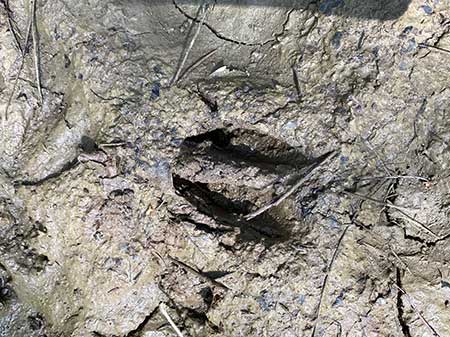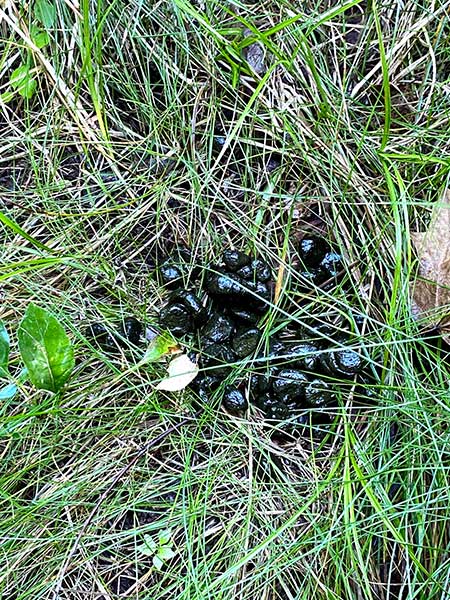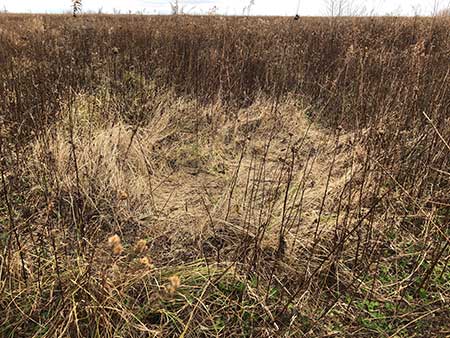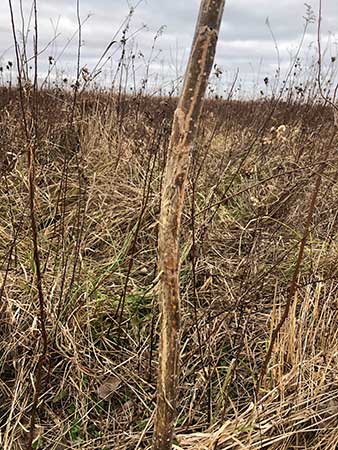No matter when you do it, the goal when scouting deer is to figure out the areas that deer are frequenting and how they travel between those areas. There are two main ways to do this.
- Direct observations: Either through watching deer or by using camera traps, you can get great information on deer habits; however, it’s hard to be in the right place at the right time.
- Reading sign: Much more information can be gathered by reading the sign deer leave behind because the sign persists in that spot for much longer.
Ultimately, scouting is a combination of direct observations and reading sign and the landscape to locate deer activity and predict future movements. Here are tips on how to scout and interpret deer sign.
- Types of deer sign
- Tracks are an animal’s individual footprints. Deer tracks are heart-shaped with a small gap running down the middle. The softness of the ground will determine how clearly you can see a track.

- Trails are frequent routes of travel where repeated footfalls have worn down soil and vegetation.
- Scat is an animal’s fecal droppings. Deer scat generally consists of multiple bullet-shaped pellets. Each pellet usually has a small dimple on one side of it. These can appear scattered or clumped together depending on the individual deer’s diet.

- Browse is the part of a deer’s diet that consists of leaves, twigs, and tree buds. Browsed vegetation looks like it’s been roughly cut. In areas of high deer density, it’s common to find browse lines where deer have eaten back any woody vegetation within reach.
- Bed is the impression on the ground made when an animal lies down for an extended period. Deer beds are about 3 feet long and oval shaped. They typically appear as matted down vegetation or packed-down snow. Beds found in thick cover were likely used during the day, while those in more open areas were usually made at night.

- Rubs are formed when a buck rubs its antlers against small trees or shrubs. Rubs communicate dominance, territory boundaries, and reproductive fitness to other deer.
- Scrapes are made by bucks as they scrape the ground with their front feet, exposing bare soil. Bucks also rub their foreheads on twigs above the scrape and urinate on the scrape to spread their scent. This is another form of communication with other deer during the rut.

- General tips on scouting
- Two important locations to find are feeding areas and bedding areas. Does almost always follow a daily bed-to-feed pattern. Bucks follow a similar pattern for most of the year, except during the rut, when they spend most of their time looking for does that are ready to breed.
- Harvested crop fields and oak trees that are dropping acorns are the most popular feeding areas in the fall.
- Bedding areas are in places where deer feel safe. Typical spots have cover the deer can hide in, but also give them a vantage point from where they can see danger approaching. They often bed with their backs toward the wind so they can smell anything coming up from behind.
- Once you find feeding and bedding areas, try to find how the deer are traveling between them. Deer frequently use the path of least resistance. Finding a well-worn trail with fresh tracks is a sign of an active travel route.
- Read the landscape to find obstacles or terrain that can restrict a deer’s movement and force it to come through a particular area. These are called funnels or pinch points. Examples include creek crossings, openings in briar thickets, and gaps in fences.
- If you find a fresh trail, follow it. It will likely lead you to feeding and bedding areas. It can also lead to higher traffic trails.
- Transitions or edges where one habitat type meets another are great places to find deer sign. Edges of woods where they meet agricultural fields are a great example. A more subtle example is where an area of young, densely growing trees meets a more open stand of mature timber.
- Don’t set up a tree stand over the first new tracks you find. The goal is to find high concentrations of fresh sign. The best locations to hunt have large quantities of multiple types of sign. Spots like these indicate extensive deer activity, and hunting in these areas puts the odds of success in your favor.
- Finding as much sign as you can will enable you to gain a more complete picture of the area you hunt and help you adjust your strategy if deer change their patterns and stop visiting the same spots.
- In-season scouting
Scouting during the preseason can teach you a lot about your area; however, once fall begins, deer start to change their habits, and it’s important to gather new information.
There are some valid concerns when it comes to scouting in an area where you are already hunting. Walking around and spreading your scent runs the risk of pressuring deer into limiting their daytime activity or leaving an area. Nevertheless, the advantage of gathering fresh information is often worth that risk. You can also bring your bow or firearm with you while scouting to potentially harvest a deer if you see one.
Here are some tips to avoid pressuring deer while scouting in-season:
- Walk slowly and quietly.
- If you are hunting public land, do most of your scouting in the middle of the day. This will minimize encountering other hunters who will mostly be out in the mornings and evenings.
- Scout as much as you can in one day. It’s better to have one day where you cover a lot of ground rather than making frequent visits on different days.
